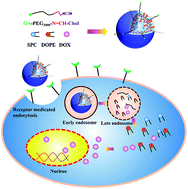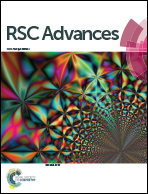Novel glycyrrhetinic acid conjugated pH-sensitive liposomes for the delivery of doxorubicin and its antitumor activities
Abstract
Over the last few decades pH-sensitive drug delivery systems have been successfully developed for the treatment of cancers by improving the therapeutical effect. In this study, a novel pH-sensitive conjugate glycyrrhetinic acid–polyethylene glycol–Schiff bond–cholesterol (GPSC) has been synthesized successfully and used to construct doxorubicin (DOX)-loaded liposomes (GPSLP/DOX) with both pH-sensitive features and active targeting ability. DOX was incorporated into liposomes using a thin-film hydration method with a relatively high encapsulation efficiency (EE%) and drug loading content (LC%). Physicochemical characteristics, in vitro release behavior, cellular toxicity and cellular uptake, in vivo biodistribution as well as in vivo antitumor activities of GPSLP/DOX were investigated. GPSLP/DOX showed significantly pH-sensitive features in the in vitro release assay. All the blank liposomes were nontoxic in the in vitro cytotoxicity assay. In the MTT assay, GPSLP/DOX showed the highest cell cytotoxicity among all the groups. A cellular uptake study revealed that GPSLP/DOX could be taken up efficiently via receptor-mediated endocytosis and pH-responsive drug release of DOX into cytoplasm, which resulted in a higher cytotoxicity and therapeutical effect. An in vivo NIR fluorescence image study showed that GPSLP/DOX could specifically accumulate in the liver and tumor sites via receptor mediated endocytosis. In vivo antitumor activity results showed that this novel GPSLP/DOX could significantly inhibit tumor growth and prolong survival time due to its pH-responsive behaviour and GA-mediated endocytosis, resulting in a lower systematic toxicity and higher therapeutical effect. All these results confirm that this GA-mediated pH-sensitive GPSLP/DOX is a novel nanocarrier for the delivery of the antitumor agent DOX to reach higher toxicity effects against tumor tissue.


 Please wait while we load your content...
Please wait while we load your content...